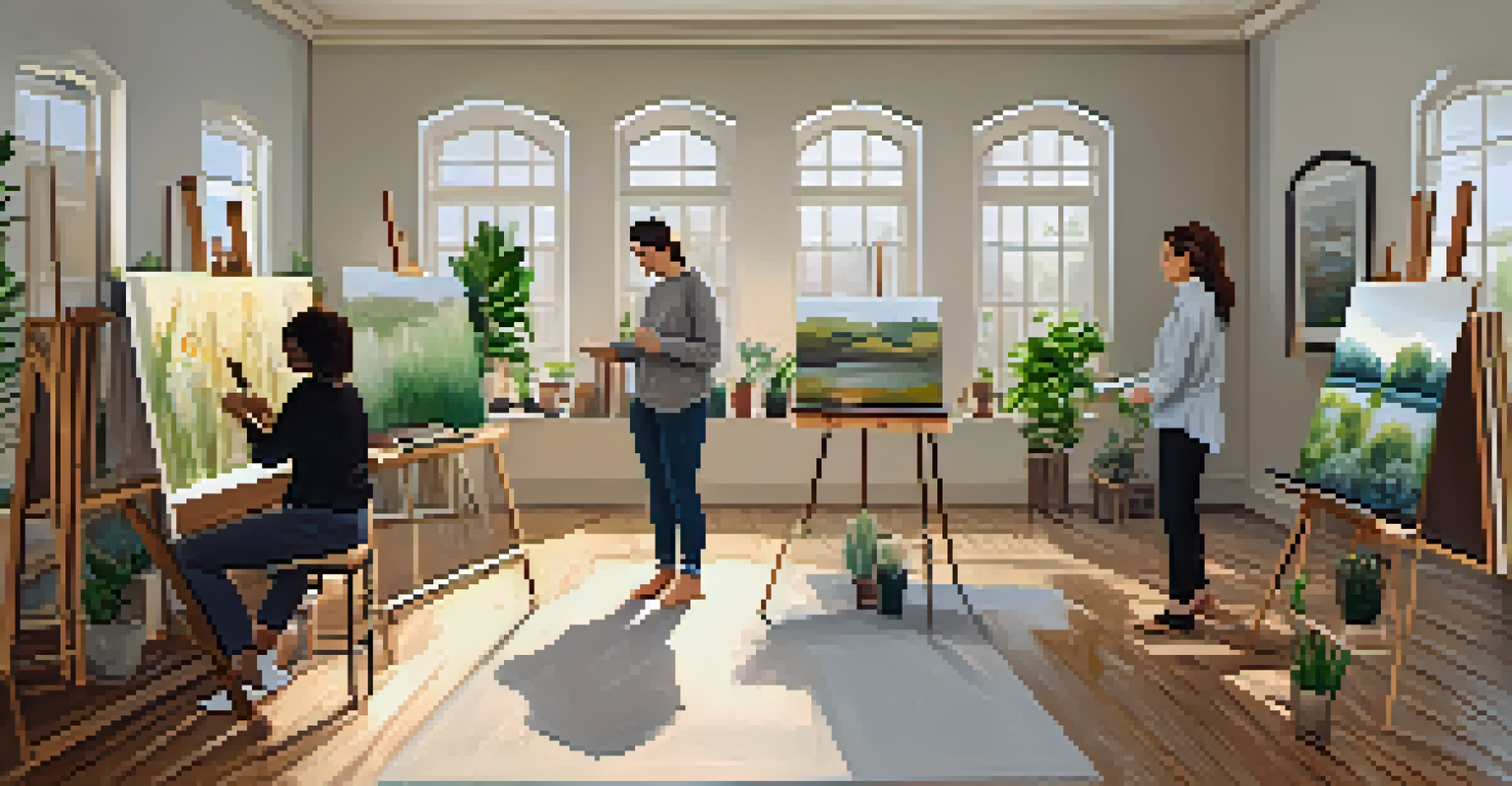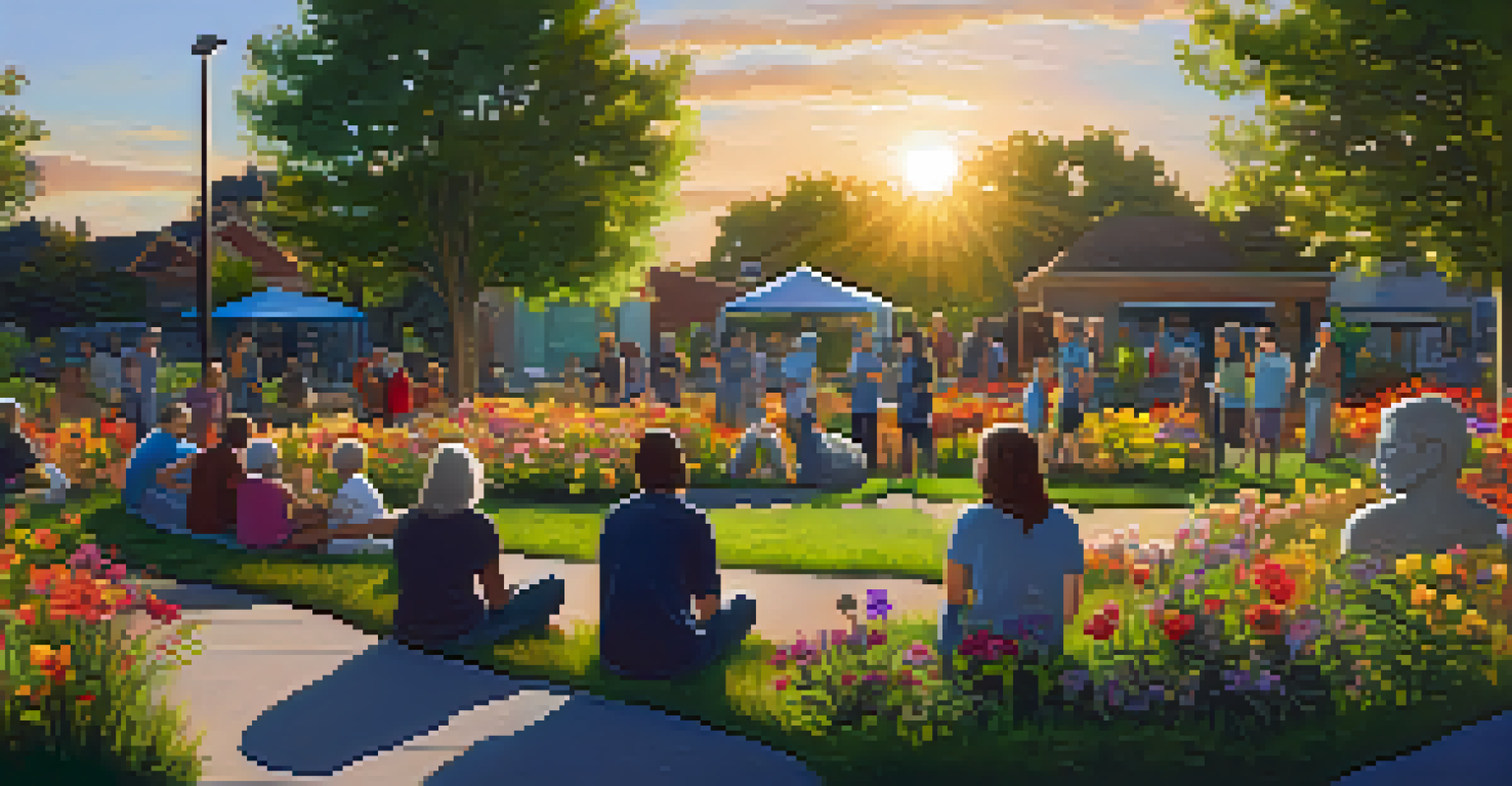Art Healing: Using Creativity to Foster Community Resilience

Understanding Art Healing and Its Benefits
Art healing is a therapeutic approach that utilizes creative expression to promote emotional well-being. By engaging in artistic activities, individuals can explore feelings they may struggle to communicate verbally. This process not only aids personal healing but also encourages a sense of community among participants.
Art enables us to find ourselves and lose ourselves at the same time.
When people come together to create, they share experiences and foster connections that can lead to stronger support systems. For instance, community art projects like murals or workshops allow individuals to contribute their unique perspectives, making them feel valued and heard. This sense of belonging can be particularly healing in times of crisis.
Moreover, art can serve as a powerful tool for storytelling. Through visual arts, music, or writing, communities can document their experiences, challenges, and triumphs, creating a shared narrative that strengthens resilience. These collective stories can inspire hope and motivate others to engage in their own healing journeys.
The Role of Community in Art Healing
Community plays a pivotal role in the art healing process, as it provides a safe space for individuals to express themselves freely. When people come together around a shared creative experience, they create an environment where vulnerability is embraced. This openness fosters trust, allowing participants to connect on a deeper level.

For example, community art initiatives often feature group projects that require collaboration, such as creating a large mural. These collaborations encourage participants to communicate and work together, cultivating a sense of unity. This teamwork not only enhances the final artwork but also strengthens community bonds.
Art Healing Enhances Emotional Well-Being
Engaging in artistic activities promotes emotional healing by allowing individuals to express feelings that are difficult to articulate verbally.
Additionally, community-driven art healing initiatives can help address specific local issues. By focusing on themes relevant to their experiences, communities can create art that reflects their struggles and aspirations. This shared creative process can empower individuals to confront challenges and envision positive change together.
Art Therapy: A Professional Approach
Art therapy is a more structured form of art healing, led by trained therapists who guide individuals in using art as a therapeutic tool. This approach combines psychology and art-making to help clients explore their emotions and develop coping strategies. It’s especially beneficial for those dealing with trauma or mental health issues.
Creativity takes courage.
In art therapy sessions, individuals can express themselves without the pressure of creating a 'perfect' piece of art. This freedom allows for genuine exploration and can reveal underlying emotions or thoughts that may need to be addressed. The therapist provides support and insight throughout the creative process.
Moreover, art therapy can be tailored to meet the unique needs of different groups, including children, veterans, or those recovering from addiction. By creating a safe and supportive environment, art therapists can help participants unlock their creativity and foster resilience in a way that resonates with their personal experiences.
Case Studies: Successful Art Healing Initiatives
Across the globe, numerous art healing initiatives have proven effective in fostering community resilience. One notable example is the 'Mural Arts Program' in Philadelphia, which employs art to revitalize neighborhoods and engage residents in meaningful projects. This program not only beautifies the community but also empowers residents to take ownership of their environment.
Another inspiring case is the 'Healing Arts Program' in hospitals, where patients participate in creative workshops. These initiatives have shown to improve mental health outcomes, reduce anxiety, and promote healing during recovery. The positive impact of art in these high-stress environments underscores its potential as a healing force.
Community Drives Art Healing Success
Collaborative art projects create a safe space for individuals to connect, fostering trust and a sense of belonging among participants.
These case studies illustrate how art healing initiatives can create positive change and foster connections among community members. By participating in collective creative experiences, individuals can find solace and support while contributing to a greater purpose.
Creating Accessible Art Programs for All
Accessibility is crucial in ensuring that art healing programs can reach diverse populations. Communities should strive to create inclusive environments where everyone, regardless of age, background, or ability, can participate. This may involve offering free workshops, providing materials, or partnering with local organizations to broaden outreach.
For example, mobile art programs that travel to underserved neighborhoods can bring creative opportunities directly to those who may not have access otherwise. These programs can engage individuals in meaningful artistic experiences, breaking down barriers that often prevent participation in traditional settings.
Additionally, incorporating various art forms—such as music, dance, or theater—can appeal to a wider audience. By offering multiple avenues for expression, communities can ensure that everyone has a chance to connect, heal, and grow through creativity.
The Healing Power of Nature and Art
Nature has a profound impact on mental well-being, and combining it with art can amplify healing effects. Outdoor art projects, like creating installations in parks or gardens, allow individuals to connect with their surroundings while expressing their creativity. This blend of nature and art can foster a sense of peace and belonging.
For instance, community gardens that incorporate art elements—such as sculptures or painted benches—encourage residents to engage with both nature and creativity. These spaces become havens for relaxation and inspiration, promoting mental health and community cohesion.
Art Therapy Offers Structured Support
Led by trained therapists, art therapy combines psychology with creativity, helping individuals explore emotions and develop coping strategies.
Moreover, nature-based art therapy sessions can leverage the calming effects of the outdoors to enhance the therapeutic experience. Participants can create art inspired by their natural surroundings, allowing them to express their feelings while connecting with the healing aspects of nature.
Looking Ahead: The Future of Art Healing
As awareness of the benefits of art healing continues to grow, the future looks promising for community resilience initiatives. More organizations are recognizing the importance of integrating art into mental health and community programs. This shift can lead to increased funding and support for creative projects that foster healing.
Additionally, the rise of digital art and online platforms offers exciting opportunities for remote engagement. Virtual workshops and art challenges can connect individuals across geographical boundaries, creating a global community focused on creativity and resilience. This adaptability ensures that art healing remains accessible in a rapidly changing world.

Ultimately, the ongoing evolution of art healing will continue to empower communities to harness their creativity as a source of strength. By embracing artistic expression, communities can cultivate resilience, foster connections, and inspire hope in the face of adversity.